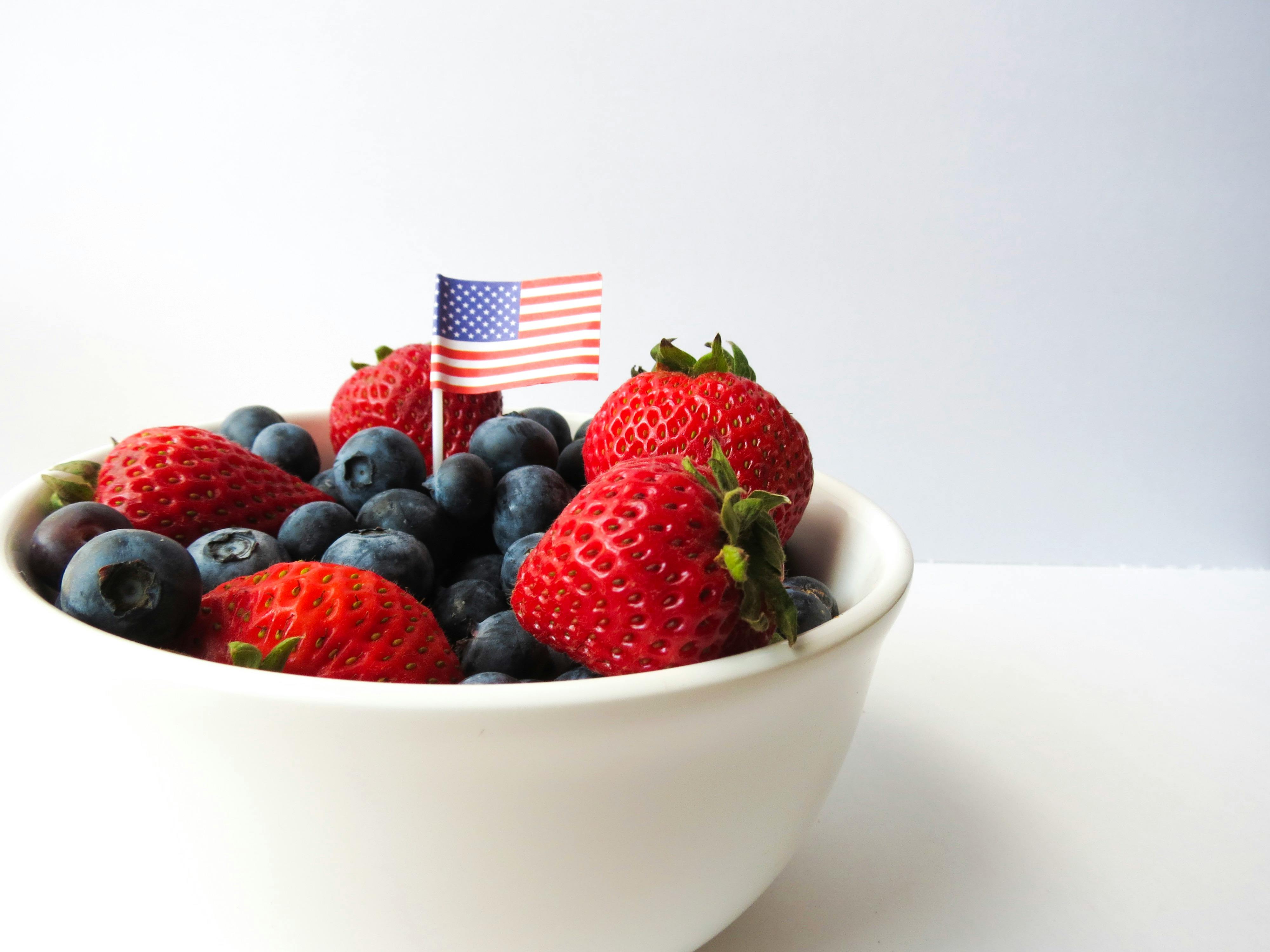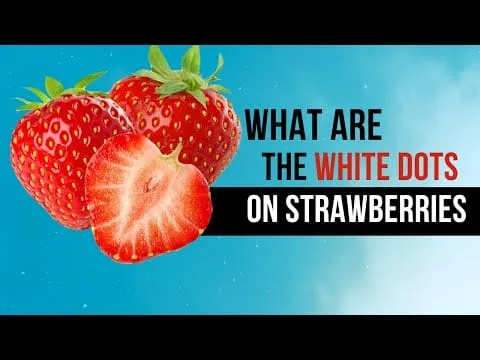Strawberries are a delicious and nutritious fruit with a bright red color and a sweet flavor. However, sometimes you may notice small white spots or patches on the surface of the berries. These white spots can be a bit off-putting, but don’t worry! In this article, we’ll explore what causes these white spots on strawberries and how to prevent them.White spots on strawberries can be caused by a variety of factors, including improper storage, damage from pests, fungal diseases, sunburn and nutrient deficiencies. Improper storage can lead to the formation of white spots due to excessive moisture. Pests such as sap beetles and strawberry weevils can cause damage to the strawberry that results in white spots. Fungal disease, such as grey mold and powdery mildew, may also cause white spots on strawberries. In addition, too much sun exposure can cause the formation of sunburned areas on strawberries that are characterized by white spots. Lastly, nutrient deficiencies in the soil can prevent berries from developing fully and may cause discolored spots on the fruit.
Types Of White Spots On Strawberries
Strawberries are a delicious and nutritious treat that can be enjoyed in many ways. Unfortunately, they can also develop white spots, which can take away from their appearance and make them less desirable. While there are a few different types of white spots on strawberries, they all have one thing in common – they aren’t good for the fruit. Here are some of the most common types of white spots on strawberries and what causes them:
1) Gray Mold (Botrytis cinerea): This type of white spot is caused by a fungus, which is often present in areas with high humidity and temperatures. The fungus produces grayish-white spots on the surface of the strawberry that can range from tiny to large. These spots are often associated with a fuzzy grayish-white film on the berry, which is why it’s sometimes called gray mold.
2) Powdery Mildew (Erysiphe cichoracearum): This type of white spot is caused by another fungus that thrives in cool, damp environments. It’s characterized by small circular patches of white powdery material on the surface of the strawberry. In severe cases, it can cause yellowing or browning of the leaves and stems as well as stunted growth.
3) Sunburn: Sunburn occurs when strawberries are exposed to too much direct sunlight for an extended period of time. The result is small white spots on the berry’s surface that look like little dots or blemishes. Sunburn generally happens when strawberries are not properly shaded or protected from direct sunlight during hot summer days.
4) Physiological Disorders: Physiological disorders occur when strawberries don’t receive enough water or nutrients from the soil or when there is an imbalance between nitrogen and phosphorous levels in the soil. As a result, these disorders can cause discoloration and patches of white on the berry’s surface, making it appear unappetizing.
White spots on strawberries can be unsightly and make them less desirable to eat, so it’s important to identify what type of spot you’re dealing with so you can take steps to prevent it from happening again in the future. With proper care and attention, you should be able to enjoy your strawberries without any worries about pesky white spots ruining your fruits!
Is It Safe To Eat Strawberries With White Spots?
Strawberries are a delicious and nutritious summertime treat, but what about strawberries that have a few white spots on them? Is it safe to eat these strawberries or should you throw them out? The answer to this question depends on the type of white spots that are present on the strawberries.
White spots on strawberries can be caused by several different things, including insects, fungi, and bacteria. Insects can leave little white marks on the strawberry’s surface that may look like light dots or lines. These marks are generally harmless and can be easily washed off with cold water.
Fungal diseases such as powdery mildew can also cause white spots on strawberries. If the strawberry has a fuzzy coating that is white in color, then it is likely a sign of a fungal infection and should not be eaten.
Bacterial infections can also cause white spots to form on strawberries. These spots usually appear as small patches of white, tan, or gray. If the strawberry is oozing any liquid or has an unpleasant smell, then it is probably not safe to eat and should be discarded immediately.
In general, if the strawberry has white spots from insects or dirt, then it is safe to eat after washing thoroughly with cold water. However, if the strawberry has any signs of fungal or bacterial infection (such as fuzzy coatings or oozing liquid), then it should be thrown out immediately for safety reasons.
Preventing White Spots on Strawberries
Strawberries are a delicious and healthy treat that can be enjoyed in a variety of ways. However, when white spots start to appear on the fruit, it can be disheartening and unappealing. Fortunately, there are several steps you can take to prevent white spots from forming on your strawberries.
The first step in preventing white spots on strawberries is to select berries that have been harvested at their peak ripeness. Overripe strawberries are more susceptible to developing white spots due to their increased water content, so it’s best to avoid these if possible. Additionally, look for berries that are firm and have bright coloration. This will help ensure that the strawberries you purchase are as fresh as possible.
Once you’ve purchased your strawberries, it’s important to store them properly in order to maintain their freshness. Strawberries should be kept refrigerated at all times and should not be left out at room temperature for extended periods of time. It’s also important to store them in an airtight container in order to prevent moisture from accumulating inside the container and causing the berries to spoil more quickly.
Finally, it’s important to wash your strawberries before consuming or using them in recipes. This will help keep the fruit clean and free of any bacteria or contaminants that could potentially cause white spots or spoilage. Be sure not to soak the berries for too long or scrub them too vigorously as this could damage the skin of the fruit and make them more prone to developing white spots.
By following these simple steps, you can help ensure that your strawberries remain fresh and free of any unsightly white spots!
Differentiating Between Good and Bad White Spots On Strawberries
When it comes to strawberries, one of the most common issues that arise is white spots. While some white spots indicate that the strawberries are not edible, others can be eaten with no problem. Knowing the difference between good and bad white spots on strawberries is important for anyone who enjoys eating this delicious fruit.
Good white spots on strawberries are typically small and slightly raised. They are usually found in clusters or patches, and are often referred to as “sugar spots.” These types of white spots are harmless and can be eaten without any issue. They are caused by a sugar deposit that forms on the strawberry due to environmental factors such as temperature, humidity, and light.
Bad white spots on strawberries, however, are much larger and deeper than sugar spots. These types of white spots usually appear in single dots or as patches of multiple dots. They can also have a yellowish hue to them and they may be slightly slimy or mushy when touched. Bad white spots are caused by mold or mildew, which means they should not be eaten as they can make you sick.
If you find white spots on your strawberries, it is always best to err on the side of caution and discard them rather than risk eating them. If the white spot appears to be a sugar spot rather than mold or mildew, then you can feel confident that it is safe to eat. Remember that when it comes to differentiating between good and bad white spots on strawberries, your best bet is always to throw them out just in case.

How to Tell If a Strawberry is Ripe Despite Having White Spots
The presence of white spots on a strawberry can be confusing. Some people assume that it means the strawberry is bad, but this isn’t necessarily the case. While white spots could indicate that a strawberry is overripe, they could also indicate that the berry is perfectly ripe and ready to eat. The best way to tell if a strawberry is ripe despite having white spots is by looking at its color, texture, and smell.
When it comes to color, ripe strawberries are typically bright red all over with no signs of green. If you notice any green patches on the fruit, it’s probably not yet ripe enough to eat. Additionally, strawberries with white spots should have a more vivid color than those without them.
The texture of a ripe strawberry should be firm and slightly springy when you press your fingers into it. If the berry has gone too soft and squishy in any areas then it’s likely overripe. In addition to this, look for any signs of mold or mushiness as these indicate that the berry has gone bad.
Finally, give the strawberry a sniff – if it smells sweet and fruity then you know it’s ripe and ready to eat! If there’s no smell at all or an off-putting smell then discard the berry and choose another one instead.
To sum up, look for bright red color all over with no green patches; press your fingers into the berry – if it’s firm and slightly springy then it’s likely ripe; finally give the strawberry a sniff – if it smells sweet and fruity then it’s ripe and ready to eat!
How To Treat White Spots On Strawberries
White spots on strawberries can be caused by a variety of things, such as a fungus called powdery mildew. This fungus is typically caused by excessive moisture, which can occur from over-fertilizing or from planting too close together. If left untreated, these white spots can spread and ruin the entire crop. Luckily, there are a few methods for treating white spots on strawberries and preventing them from occurring in the future.
The first step to treating white spots on strawberries is to remove any affected berries. This will help lessen the spread of the fungus and will also help increase air circulation around the plants, which will reduce moisture buildup. Once all affected berries have been removed, it’s important to spray the plants with a fungicide that is specifically designed for use on strawberries. This will help prevent further spread of the fungus and should be done every 7-10 days during peak growing season.
It’s also important to create an environment that is not conducive to powdery mildew formation in order to prevent white spots from occurring in the future. This includes making sure that plants are spaced out properly and not planted too close together, as well as avoiding over-fertilizing or overwatering. Additionally, making sure to keep weeds away from the strawberry patch can also help reduce moisture buildup and prevent powdery mildew from forming.
Finally, if you notice any signs of white spots on your strawberries despite taking preventive measures, it’s important to act quickly in order to stop them from spreading further. As mentioned above, removing affected berries and spraying with a fungicide are two key steps in controlling the spread of this fungus and keeping your strawberry crop healthy throughout the season.
By following these steps, you should be able to successfully treat white spots on your strawberries and keep them safe until harvest time!
Identifying Signs of Disease For White Spots On Strawberries
White spots on strawberries can be a sign of several diseases and should be taken seriously. It is important to identify the signs of disease so that appropriate steps can be taken to prevent further damage. Below are some common diseases associated with white spots on strawberries.
Botrytis Fruit Rot
Botrytis fruit rot is caused by a fungal infection, often caused by wet weather. The white spots may appear as greyish or yellowish patches on the strawberry fruit and if left untreated, can cause the entire fruit to rot away. To prevent this disease from occurring, it is important to keep the area around the plants dry and well-ventilated, and avoid watering in the evening.
Anthracnose
Anthracnose is another fungal disease that can cause white spots to appear on strawberry fruits. This disease is most common in warm, humid climates and is typically characterized by small, white spots on the surface of the berry that may turn brown over time. To prevent anthracnose from occurring, it is important to keep the area around the plants free from debris and water only in the morning hours.
Mildew
Mildew can also cause white spots to appear on strawberry fruits. These spots will typically be small and round and may have a powdery appearance. Mildew usually occurs when there is too much moisture in the air or when there isn’t enough sunlight reaching the plant’s leaves. To prevent mildew from occurring, it is important to ensure that there is adequate airflow around the plants and avoid overwatering them.
By identifying signs of disease early, gardeners can take steps to control or eliminate these diseases before they cause significant damage to their crop of strawberries. If left untreated, these diseases can quickly spread throughout an entire patch of strawberries and ruin an entire crop.

Conclusion
It can be concluded that the white spots on strawberries are due to a number of environmental factors. These white spots occur when the strawberry is exposed to cold temperatures, prolonged sun exposure, or pests and diseases. In some cases, these white spots can be caused by a fungal infection.
The best way to prevent these white spots from occurring is to provide the strawberries with adequate water and to protect them from drastic changes in temperature. Additionally, growers should monitor their fields for pests and diseases and keep a close eye on the amount of sunlight the strawberries receive.
When purchasing strawberries, look for ones that are plump and free of any white spots or discoloration. If you come across strawberries with white spots it’s best to avoid them as they may have been exposed to fungal infections or other conditions that can make them unsafe for consumption.
By taking the necessary precautions and monitoring your fields closely, you can ensure that your strawberries will remain healthy and free of white spots.



